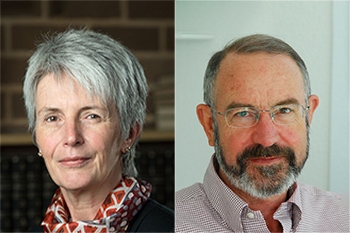
Academy Fellows Professor Jane Elith and Professor Roger Summons have been elected to the National Academy of Sciences (NAS) in the United States.
Founded in 1863 as a result of an Act of Congress approved by President Abraham Lincoln, the NAS is a society of distinguished scholars that provides independent, objective advice on matters related to science and technology.
Scientists are elected by their peers to membership in the NAS for outstanding contributions to research. NAS membership currently totals approximately 2400 American members and 500 international members. Approximately 190 members and international members have received Nobel prizes.
The Academy congratulates Professor Elith and Professor Summons on their election as international NAS members, considered one of the highest honours a scientist can receive.
Professor Jane Elith, Professor in Biodiversty Modelling at the University of Melbourne, has rapidly become one of the world’s most influential researchers in applied ecology. She specialises in species distribution models that help to better inform environmental managers and governments on invasive species, land-use and improving biodiversity.
Professor Elith received her PhD in ecology from the University of Melbourne in 2002 and has since been a Research Fellow in the School of Botany. She is currently an Australian Research Council Future Fellow within the Centre of Excellence for Biosecurity Risk Analysis at the university.
Professor Elith is one of the most highly cited ecologists in Australia and was recognised by Thomas Reuters as a highly cited researcher from 2014–2016, putting her in the top 1% of researchers globally. She has received several awards, including the 2015 Prime Minister’s prize for Life Scientist of the Year and the 2016 Fenner Medal from the Australian Academy of Science, and was elected as a Fellow of the Australian Academy of Science in 2017. Professor Elith has been a subject editor for numerous scientific journals in the fields of ecology, plant and animal species distribution and ecography and teaches specialist courses in spatial modelling.
Professor Summons is the Schlumberger Professor of Geobiology at the Massachusetts Institute of Technology (MIT). He is particularly well known for his work on the application of organic geochemical methods to study microbes to increase the understanding of the early evolution of life on Earth. Professor Summons received his PhD in organic chemistry from the University of New South Wales in 1972 after which he conducted postdoctoral and research fellowships at Stanford University and the Australian National University. Professor Summons held appointments at the Australian National University and Geoscience Australia before joining MIT in 2001. He is Principal Investigator of the MIT NASA Astrobiology Institute, where he leads a team that studies the Foundations of Complex Life, and is also a member of the Sample Analysis on Mars instrument team.
Professor Summons served on three committees of the US National Research Council from 2003 to 2007, including the Committee on Origin and Evolution of Life, the Committee on Limits of Life, and the Committee on Mars Astrobiology. He also served as NASA co-chair of the organic contamination panel for the Mars 2020 Rover. He has been a member of the editorial boards of the scientific journals Astrobiology, Geobiology and Palaeoworld since their establishment. He has received numerous awards, including the Australian Organic Geochemistry Medal (2002), the Alfred E. Treibs Award of the Geochemical Society (2003) and the Alexander von Humboldt Foundation Research Award (2008), and has been elected as a Fellow of the Australian Academy of Science (1998), the American Geophysical Union (2006), the Royal Society (2008) and the American Academy of Microbiology (2012).
© 2025 Australian Academy of Science